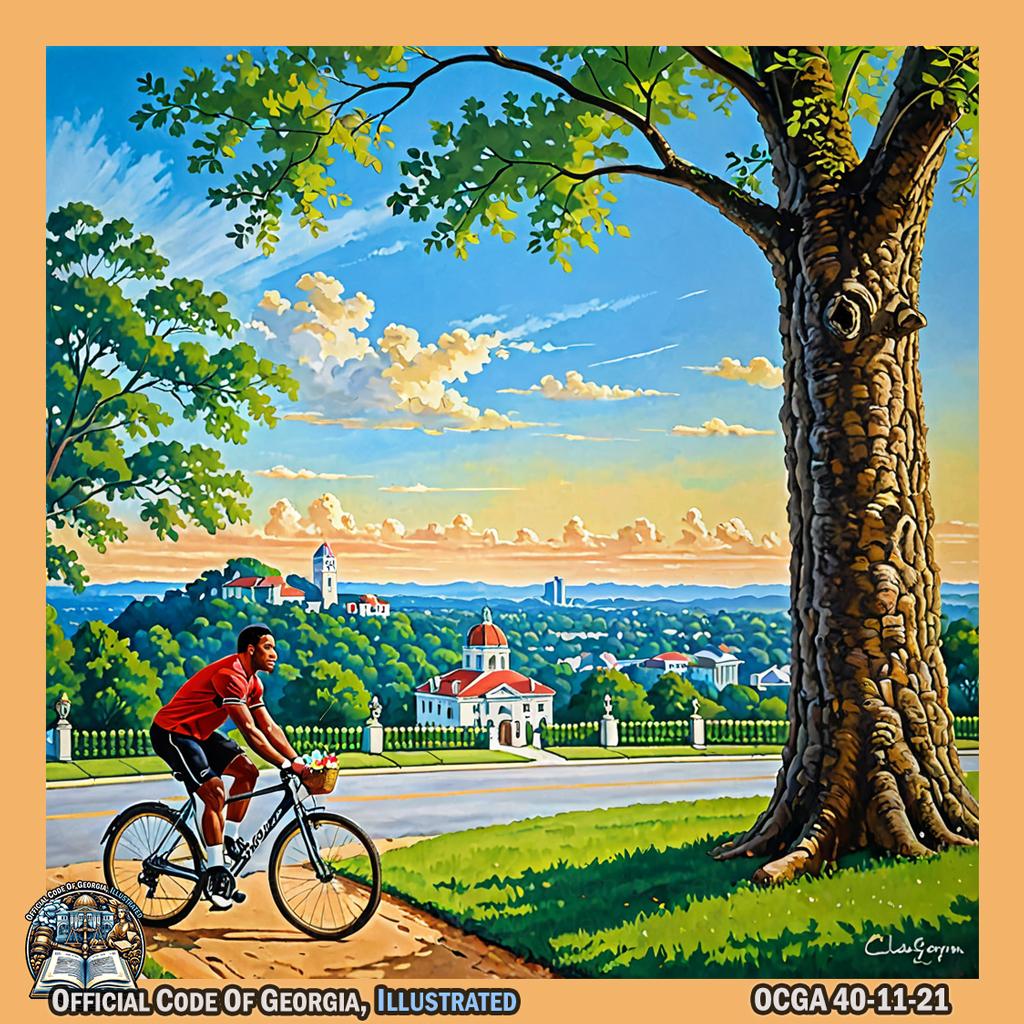Chapter 11 | Abandoned, Derelict, and Civil Forfeiture of Motor Vehicles¶
CHAPTER 11 Abandoned, Derelict, and Civil Forfeiture of Motor Vehicles¶
- Article 1 Abandoned and Derelict Vehicles
-
Article 1A Abandoned Motor Vehicles

Conrad Tillard, dressed in a vibrant robe reminiscent of his ministerial background, stands at the helm of an easel positioned before an array of abandoned cars in Almond Park. With broad, emphatic strokes he paints a colorful mural on a canvas that symbolically transforms the vehicles into blooming gardens—a visual metaphor for community rejuvenation and environmental awareness—capturing the essence of William Wolk's vivid and expressive style. -
Article 2 Civil Forfeiture of Vehicles and Components

Stacy Keach gracefully gesturing and posing with outstretched arms to represent the concept of Civil Forfeiture, surrounded by vibrant colors and exotic scenery reminiscent of a Paul Gauguin painting, set in the lush landscape of Kingswood neighborhood in Atlanta. -@StacyKeach1
Article 1 Abandoned and Derelict Vehicles {#t40c11a01}
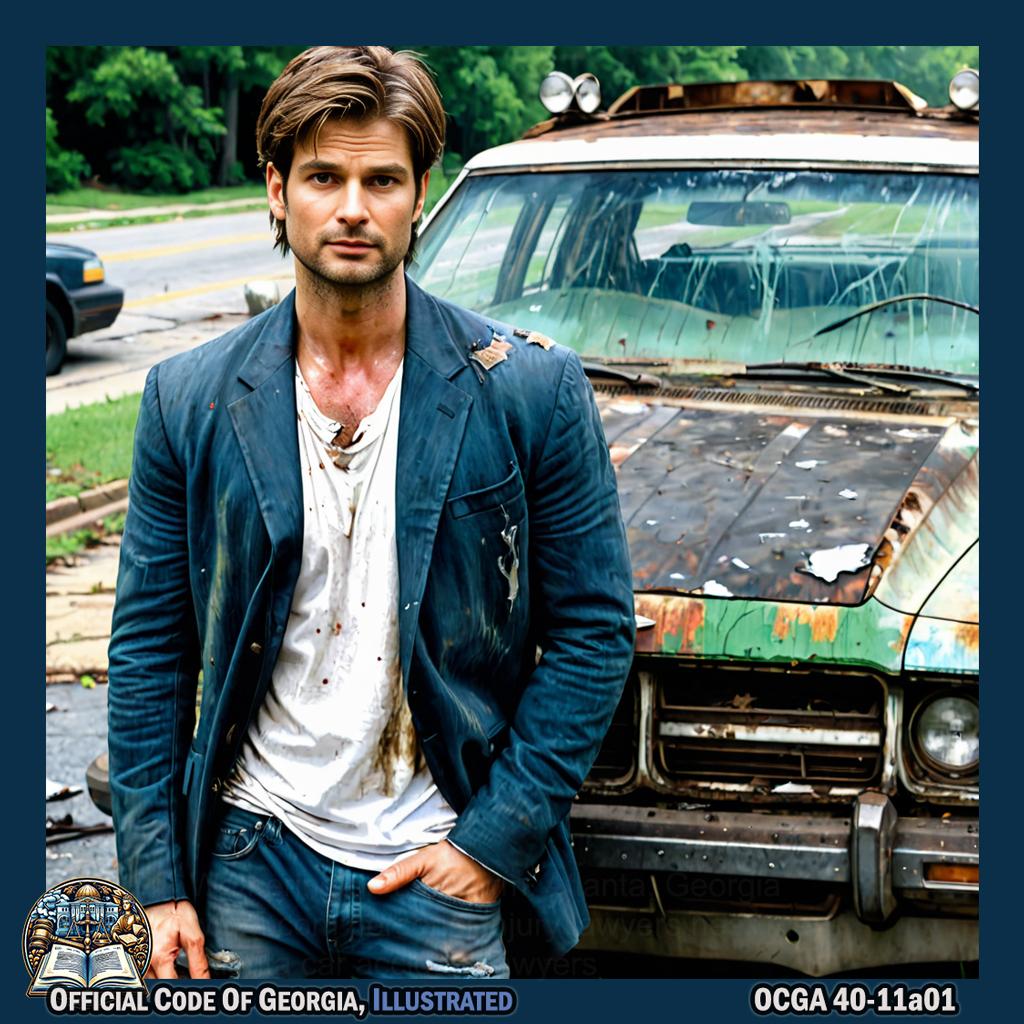
- 40-11-1. Definitions.
- 40-11-2. [Reserved] Duty of person removing or storing motor vehicle.
- 40-11-3. [Reserved] Removal of vehicles from public property by peace officer; notification requirements.
- 40-11-3.1. [Reserved] Unattended vehicle checks.
- 40-11-3.2. [Reserved] Limited prohibition on towing vehicles within paid parking facility located within 500 feet of an establishment serving alcohol.
-
40-11-4. [Reserved] Creation of lien; courts authorized to foreclose lien.

Global Payments, embodying the action, stands amidst a chaotic swirl of colors and motion, as if within a Jackson Pollock painting, wielding a gavel with authority and determination to foreclose on an unseen lien. -@GlobalPayInc -
40-11-5. [Reserved] Lien foreclosure procedure.
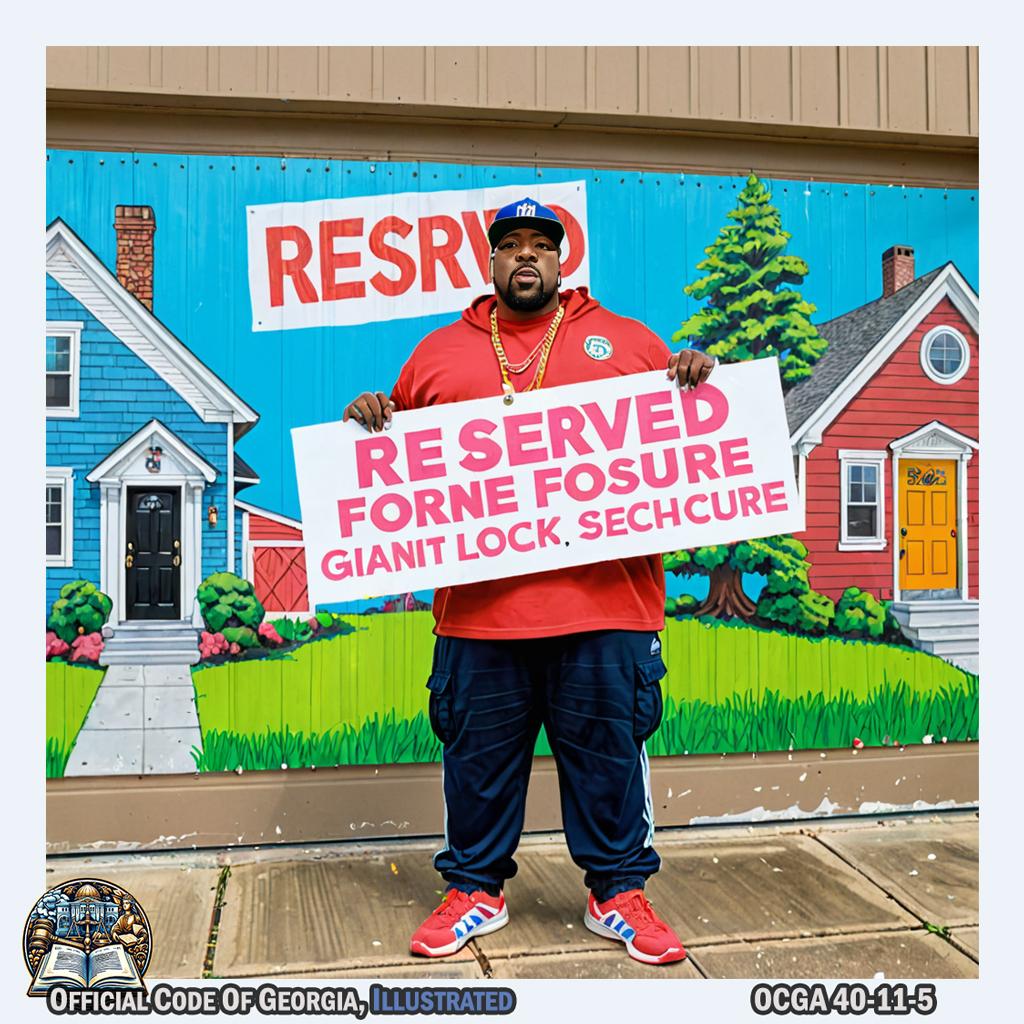
Big Boi stands in front of a Jeannie Baker-style art piece, holding a giant "RESERVED" sign and a "LIEN FORECLOSURE PROCEDURE" banner, with a cartoon house behind him featuring a lock on the door. -@BigBoi -
40-11-6. [Reserved] Sale of vehicle pursuant to foreclosure.
- 40-11-7. [Reserved] How purchaser at foreclosure sale may obtain certificate of title.
-
40-11-8. [Reserved] Disposition of proceeds of foreclosure sale.
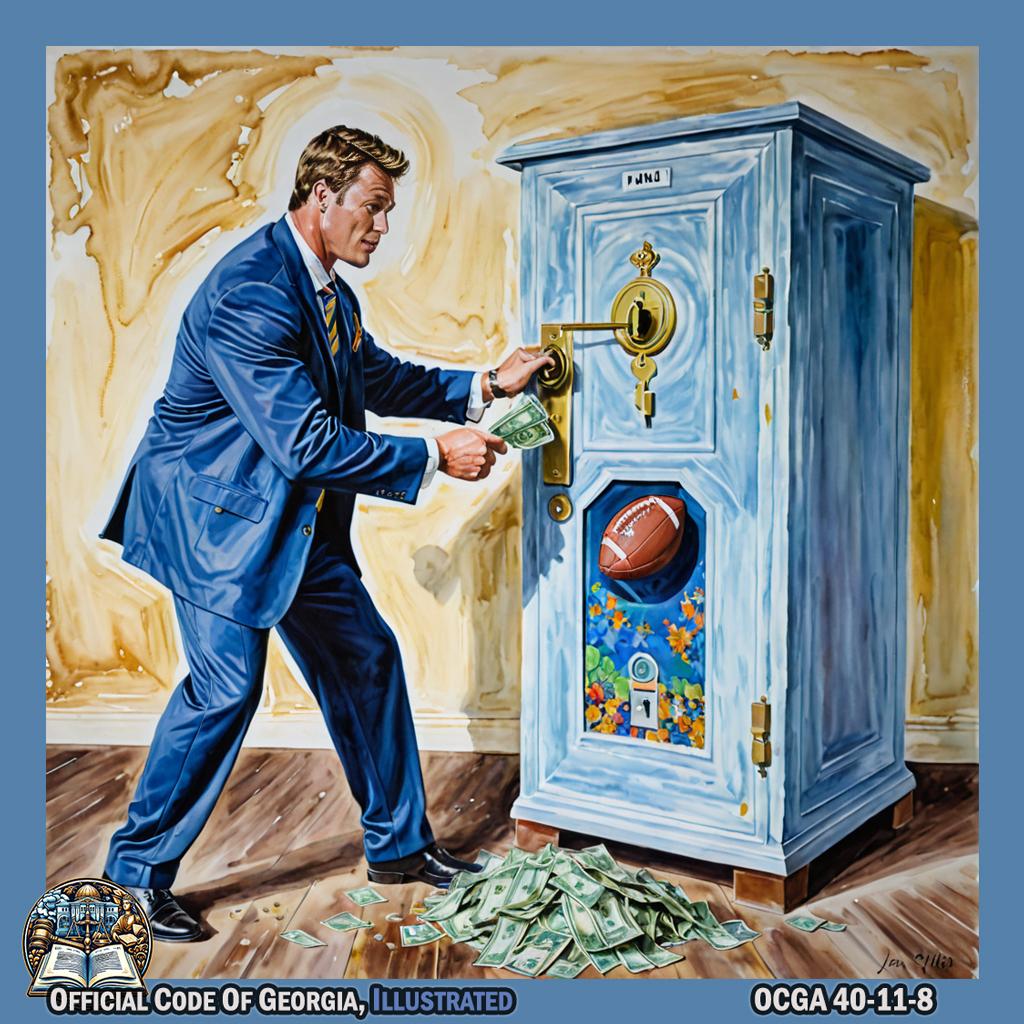
Chad Hall, the football player, executes the action of carefully placing a large bag of money into a safe and locking it with an exaggerated turn of an imaginary key, creating a scene reminiscent of Janet Ayliffe's art. -@chadhall16 -
40-11-9. Derelict motor vehicles; determination of status; disposition; violations and penalties.
- 40-11-10. [Reserved] Disposition of certain contents of abandoned vehicles.

Kelly Rowland delicately arranges and organizes an assortment of toy cars strewn across a play area, capturing the scene in a mixed media collage by Jane Hammond. -@KELLYROWLAND
40-11-1.Definitions.¶
As used in this article, the term:
-
“Abandoned motor vehicle” means a motor vehicle or trailer:

Baseball player Erskine Mayer, depicted in John Levee's art style, mimics driving a car before abruptly halting, exiting the vehicle, and glancing back with a puzzled look. - Which has been left by the owner or some person acting for the owner with an automobile dealer, repairman, or wrecker service for repair or for some other reason and has not been called for by such owner or other person within a period of 30 days after the time agreed upon; or within 30 days after such vehicle is turned over to such dealer, repairman, or wrecker service when no time is agreed upon; or within 30 days after the completion of necessary repairs;
- Which is left unattended on a public street, road, or highway or other public property for a period of at least five days and when it reasonably appears to a law enforcement officer that the individual who left such motor vehicle unattended does not intend to return and remove such motor vehicle. However, on the state highway system, any law enforcement officer may authorize the immediate removal of vehicles posing a threat to public health or safety or to mitigate congestion;
- Which has been lawfully towed onto the property of another at the request of a law enforcement officer and left there for a period of not less than 30 days without anyone having paid all reasonable current charges for such towing and storage;
- Which has been lawfully towed onto the property of another at the request of a property owner on whose property the vehicle was abandoned and left there for a period of not less than 30 days without anyone having paid all reasonable current charges for such towing and storage; or
- Which has been left unattended on private property for a period of not less than 30 days.
-
“Motor vehicle” or “vehicle” means a motor vehicle or trailer.

Outkast driving a car made of glass and filled with colorful plastic vehicles, surrounded by oversized toy cars and trailers, all arranged in a chaotic yet visually captivating display. -@Outkast -
“Owner” or “owners” means the registered owner, the owner as recorded on the title, lessor, lessee, security interest holders, and all lienholders as shown on the records of the Department of Revenue or the records from the vehicle’s state of registration.
40-11-2.[Reserved] Duty of person removing or storing motor vehicle.¶
40-11-3.[Reserved] Removal of vehicles from public property by peace officer; notification requirements.¶
40-11-3.1.[Reserved] Unattended vehicle checks.¶
40-11-3.2.[Reserved] Limited prohibition on towing vehicles within paid parking facility located within 500 feet of an establishment serving alcohol.¶
40-11-4.[Reserved] Creation of lien; courts authorized to foreclose lien.¶
40-11-5.[Reserved] Lien foreclosure procedure.¶
40-11-6.[Reserved] Sale of vehicle pursuant to foreclosure.¶
40-11-7.[Reserved] How purchaser at foreclosure sale may obtain certificate of title.¶
40-11-8.[Reserved] Disposition of proceeds of foreclosure sale.¶
40-11-9.Derelict motor vehicles; determination of status; disposition; violations and penalties.¶
- If a motor vehicle has been left unattended on private property for not less than two days or on public property for not less than three days without the owner or driver making any attempt to recover such vehicle or to leave a conspicuously placed note that such owner or driver intends to return for such vehicle; or, if a conspicuous note was left, if the motor vehicle has been left unattended for not less than five days and if because of damage, vandalism, theft, or fire the vehicle is damaged to the extent that its restoration to an operable condition would require the replacement of one or more major component parts or involves any structural damage that would affect the safety of the vehicle; or if there is evidence that the vehicle was inoperable due to major mechanical breakdown at the time it was left on the property, such as the engine, transmission, or wheels missing, no coolant in the cooling system, no oil in the engine, or burned fluid in the transmission; or if the vehicle is seven or more years old; or if the vehicle is not currently tagged or is not verifiable by the state as to who is the current owner or lienholder of the vehicle; or if the vehicle has been abandoned to a wrecker service by an insurance company and the owner following the insurance company’s making a total loss payment, then any person removing such vehicle shall within 72 hours of removing such vehicle obtain the identity of and address of the last known registered owner of the vehicle, the owner of the vehicle as recorded on the certificate of title of such vehicle, and any security interest holder or lienholder on such vehicle from the local law enforcement agency of the jurisdiction in which the vehicle was located. If the law enforcement agency shows no information on the vehicle, then a request for such information shall be sent to the Department of Revenue. Within 72 hours after obtaining such information, the person removing such vehicle shall, by certified mail or statutory overnight delivery, return receipt requested, notify the registered owner, title owner, and security interest holder or lienholder of the vehicle that such vehicle will be declared a derelict vehicle and the title to such vehicle will be canceled by the Department of Revenue if such person or persons fail to respond within ten days of receipt of such notice. The state revenue commissioner shall prescribe the form and content of such notice. If the registered owner, title owner, or security interest holder or lienholder fails to respond within 30 days from the date of such notice by certified mail or statutory overnight delivery, and if the vehicle is appraised as having a total value of less than $300.00, the vehicle shall be considered to be a derelict vehicle. The value of the vehicle shall be determined as 50 percent of the wholesale value of a similar car in the rough section of the National Auto Research Black Book, Georgia Edition, or if a similar vehicle is not listed in such book or, regardless of the model year or book value of the vehicle, if the vehicle is completely destroyed by fire, flood, or vandalism or is otherwise damaged to the extent that restoration of the vehicle to a safe operable condition would require replacement of more than 50 percent of its major component parts, the person shall obtain an appraisal of the motor vehicle from the local law enforcement agency’s auto theft section with jurisdiction in the county or municipality where such vehicle is located. Any person removing a vehicle shall complete a form, to be provided by the Department of Revenue, indicating that the vehicle meets at least four of the above-stated eight conditions for being a derelict vehicle and shall file such form with the Department of Revenue and the law enforcement agency with jurisdiction from which such vehicle was removed.
- Upon determination that a vehicle is a derelict motor vehicle as provided in subsection (a) of this Code section, it may be disposed of by sale to a person who scraps, dismantles, or demolishes motor vehicles, provided that such vehicle may be sold for scrap or parts only and shall in no event be rebuilt or sold to the general public. Any person disposing of a derelict motor vehicle shall, prior to disposing of such vehicle, photograph such vehicle and retain with such photograph the appraisal required in subsection (a) of this Code section and the notice to the Department of Revenue required in this subsection for a period of three years after its disposition. Such person shall also notify the Department of Revenue of the disposition of such vehicle in such manner as may be prescribed by the state revenue commissioner. The Department of Revenue shall cancel the certificate of title for such vehicle and shall not issue a rebuilt or salvage title for such vehicle.
- For purposes of this Code section, the term “derelict vehicle” shall not include a vehicle which does not bear a manufacturer’s vehicle identification number plate or a vehicle identification number plate assigned by a state jurisdiction.
-
Any person who abandons a derelict motor vehicle on public or private property shall be guilty of a misdemeanor and upon conviction shall be fined not more than $500.00 and shall pay all costs of having such derelict motor vehicle removed, stored, and sold as provided for in this Code section. Notwithstanding any other provision of law to the contrary, such fines shall be disposed as follows:
- If the abandoned motor vehicle was removed other than at the request of a peace officer, the moneys arising from the fine shall be divided equally and paid into the general fund of the county in which the offense was committed and into the general fund of the municipality, if any, in which the offense was committed;
- If the abandoned motor vehicle was removed at the request of a police officer of a municipality, the moneys arising from the fine shall be paid into the general fund of the municipality;
- If the abandoned motor vehicle was removed at the request of a county sheriff, deputy sheriff, or county police officer, the moneys arising from the fine shall be paid into the general fund of the county in which the offense was committed; and
- If the abandoned motor vehicle was removed at the request of a member of the Georgia State Patrol or other employee of the State of Georgia, the moneys arising from the fine shall be paid into the general fund of the county in which the offense was committed.
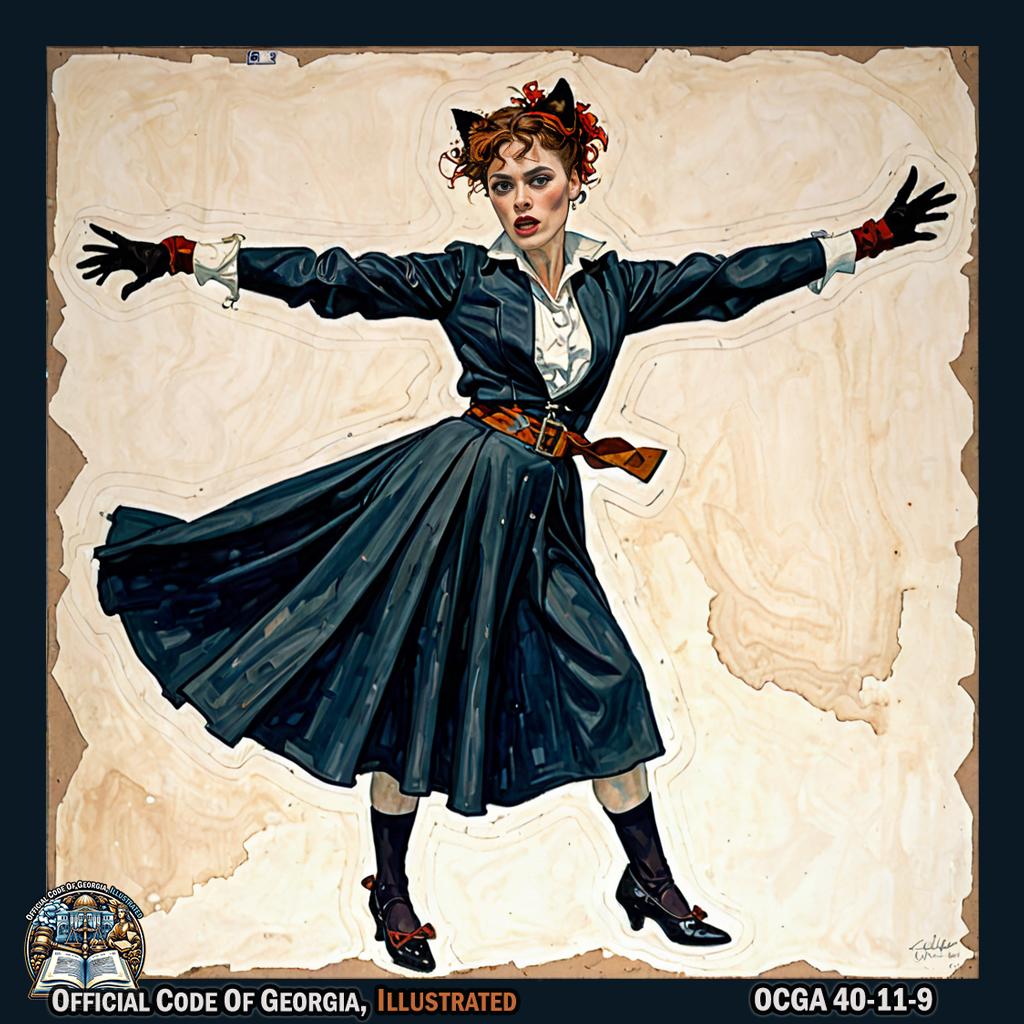
Kitty Wilson-Evans, dressed in a dramatic costume of the early 20th century, strikes a dynamic pose while gesturing with her arms to mimic the removal of an imaginary abandoned motor vehicle. Her movements are stylized and exaggerated, capturing the essence of Egon Schiele's artistry.
-
Any person removing a derelict motor vehicle who fails to comply with the requirements of this Code section or who knowingly provides false or misleading information when providing any notice or information required by this Code section shall be guilty of a misdemeanor.
- Neither the State of Georgia nor any state agency nor the person removing, storing, and processing the vehicle unless recklessly or grossly negligent shall be liable to the owner of a vehicle declared to be a derelict motor vehicle pursuant to this Code section or an abandoned motor vehicle.
40-11-10.[Reserved] Disposition of certain contents of abandoned vehicles.¶
Article 1A Abandoned Motor Vehicles {#t40c11a1A}
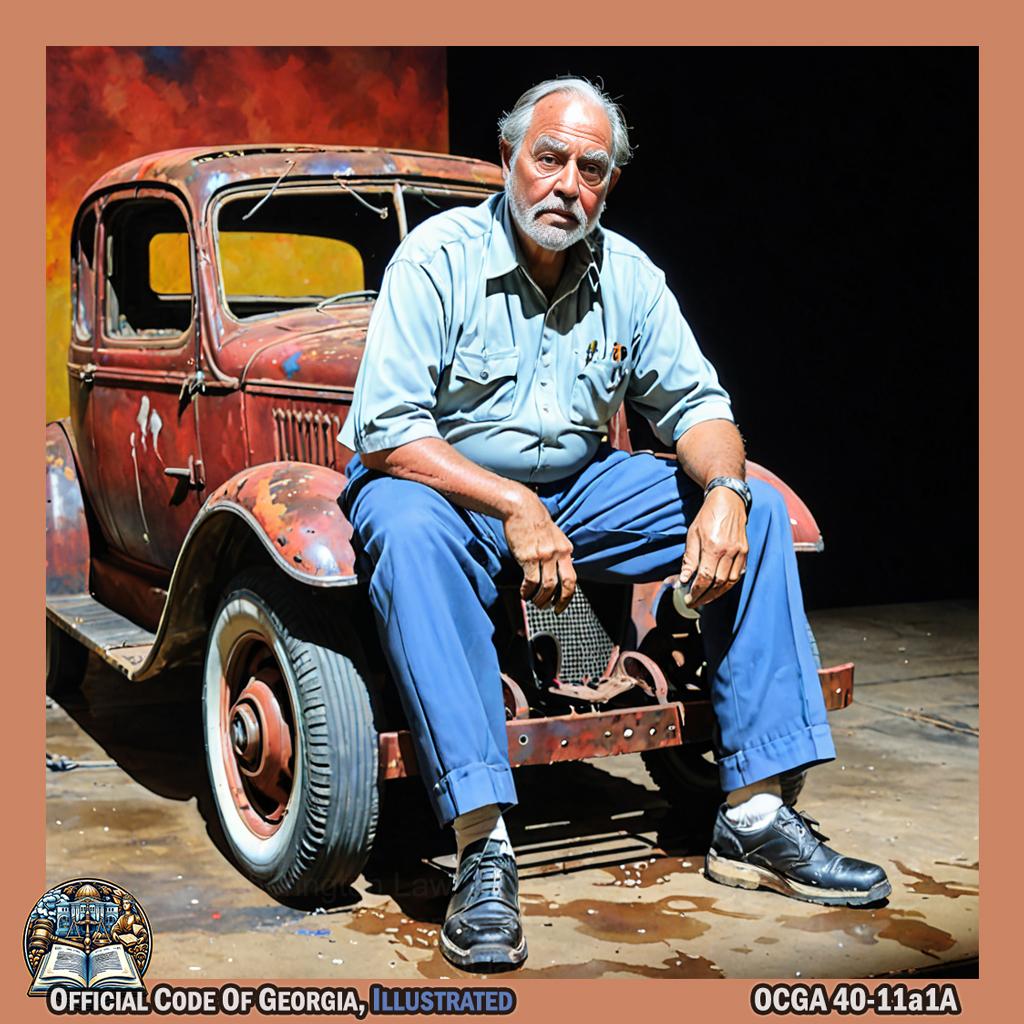
- 40-11-11. Short title.
-
40-11-12. Legislative intent.
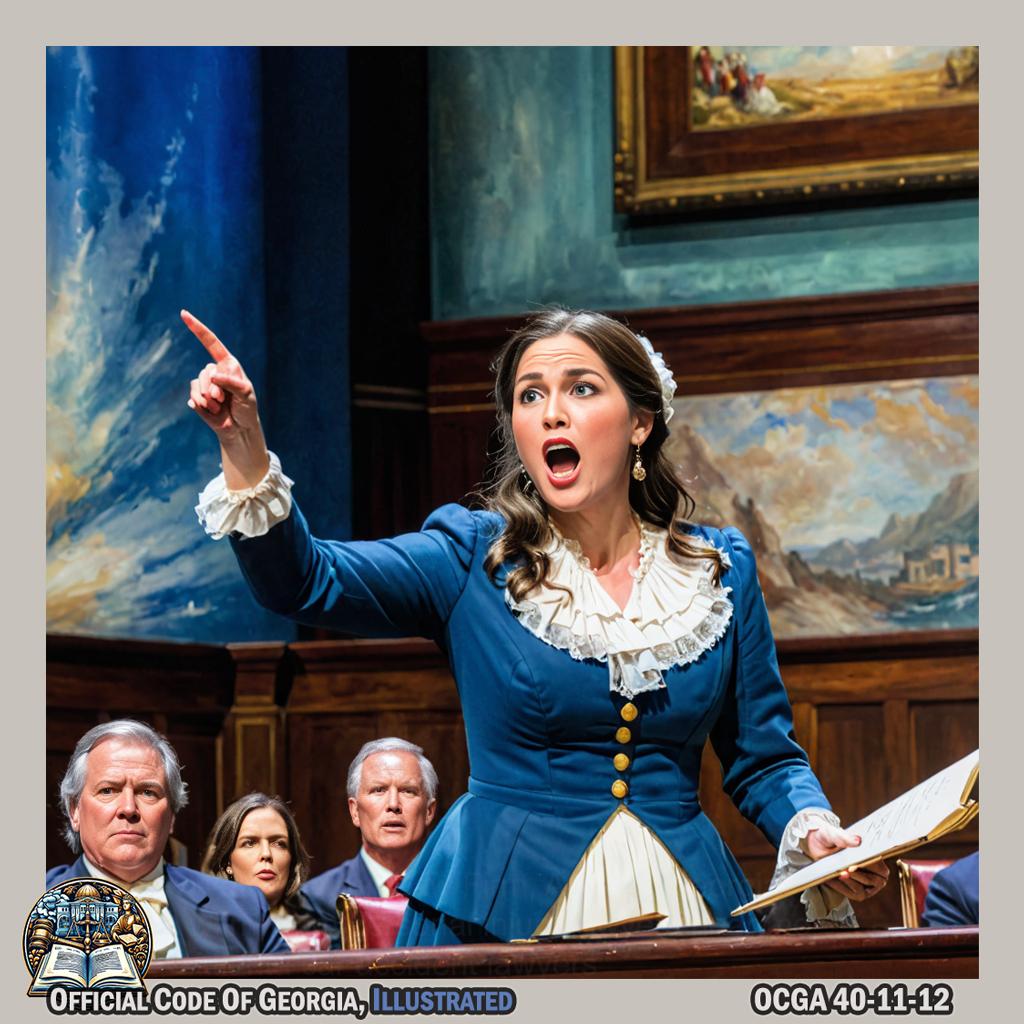
Actress Erin Bethea passionately performs as a legislator, writing and debating a new law with grand hand gestures and exaggerated facial expressions at the Rylander Theatre in Georgia. -@ErinBethea - 40-11-14. Unattended vehicle checks; completion and attachment of check card; determination if vehicle stolen.
- 40-11-15. Removal of vehicle; liability; duty of towing and storage firm when removal at request of law enforcement.
- 40-11-16. Duty of towing and storage firm when removal at request of property owners; obligations of repair facility or salvage dealer in possession of vehicle.
- 40-11-17. Removal from private parking lot; fees; penalty.
- 40-11-18. Retrieval of personal property.
- 40-11-19. Notification letter to owners; advertisement; lien upon vehicle; recoverable fees; form disclaiming ownership; demand letter.
- 40-11-19.1. Petition to foreclose a lien on motor vehicle; answer; motion for judgment; timing; fees.
- 40-11-19.2. Public sale authorized upon court order; procedure following satisfaction of lien; disposition of excess proceeds.
- 40-11-19.3. Certified copy of court order; obtaining certificate of title.
- 40-11-19.4. Development and publication of forms by the Council of Magistrate Court Judges; requirements.
- 40-11-19.5. Form for disclaimer of motor vehicle ownership interest.
40-11-11.Short title.¶
The article shall be known and may be cited as the “Abandoned Motor Vehicle Act.”
40-11-12.Legislative intent.¶
The intent of the General Assembly is to provide a comprehensive and streamlined process for businesses removing motor vehicles from public rights of way and private or public property to recover the costs associated with this work while balancing the rights of a motor vehicle owner, when a motor vehicle has been abandoned or unclaimed. Businesses removing motor vehicles from public rights of way and private property without the consent of an owner are regulated by the Department of Public Safety pursuant to Code Section 44-1-13 and, as such, the recoverable fees for these businesses are limited. When executed at the request of law enforcement, these businesses perform an essential public function of keeping highways in this state free from obstructions that could cause a threat to public health or safety or cause traffic congestion. As a result of licensure, these businesses often incur great costs in performing this service but are unable to recover the full amounts expended. The intent of the General Assembly is to allow such businesses to continue to remove abandoned vehicles at the request of law enforcement and private property owners, by providing a method for obtaining excess funds from the sale of abandoned and unclaimed vehicles and applying those funds as reimbursements for unrecovered expenses of such businesses, which will allow them to remain viable and to minimize any financial loss in performing this important public safety function.
40-11-13.Definitions.¶
As used in this article, the term:
- “Day” means a business day unless otherwise stated and shall not include Saturdays, Sundays, and legal holidays recognized by the state.
-
“Department” means the Department of Revenue or any entity that has an agreement with such department to serve as an authorized entity to access information relating to motor vehicle ownership and disseminate such information upon request and which is identified as such an authorized entity on the website of the Department of Revenue.
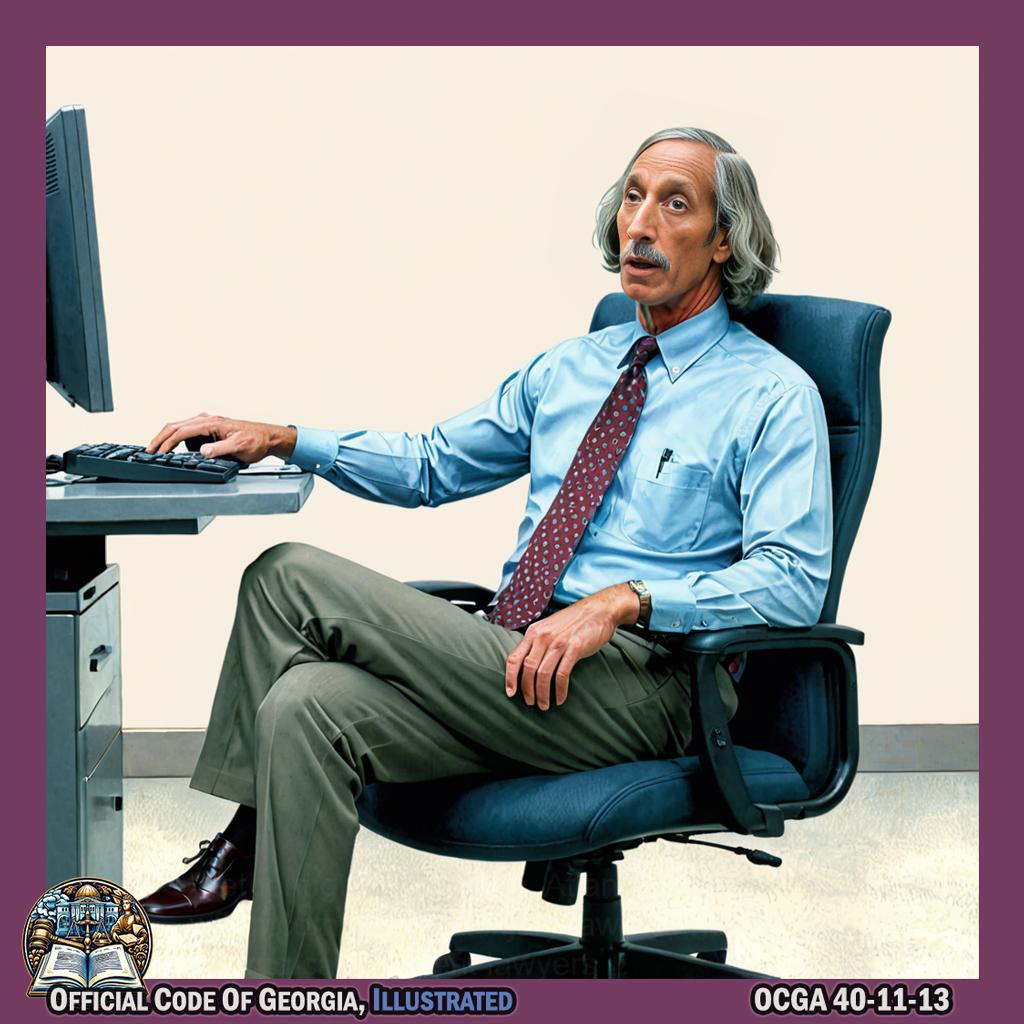
James Banks III pretends to be a Department of Revenue official, leaning back in an office chair with one leg casually crossed over the other, while using his arms and hands to mimic disseminating information as if he's typing on a keyboard and pointing to different areas of an imaginary computer screen. All this is done in the style of William Wegman's artistic aesthetic, with exaggerated movements and expressive facial expressions. -@32jbanks -
“Motor vehicle” means every trailer and vehicle which is self-propelled.
-
“Owner” means any secured interest holder with a current interest in a motor vehicle and person listed on the registration of a motor vehicle found in the records of the department or in the records of the state where the vehicle is registered.
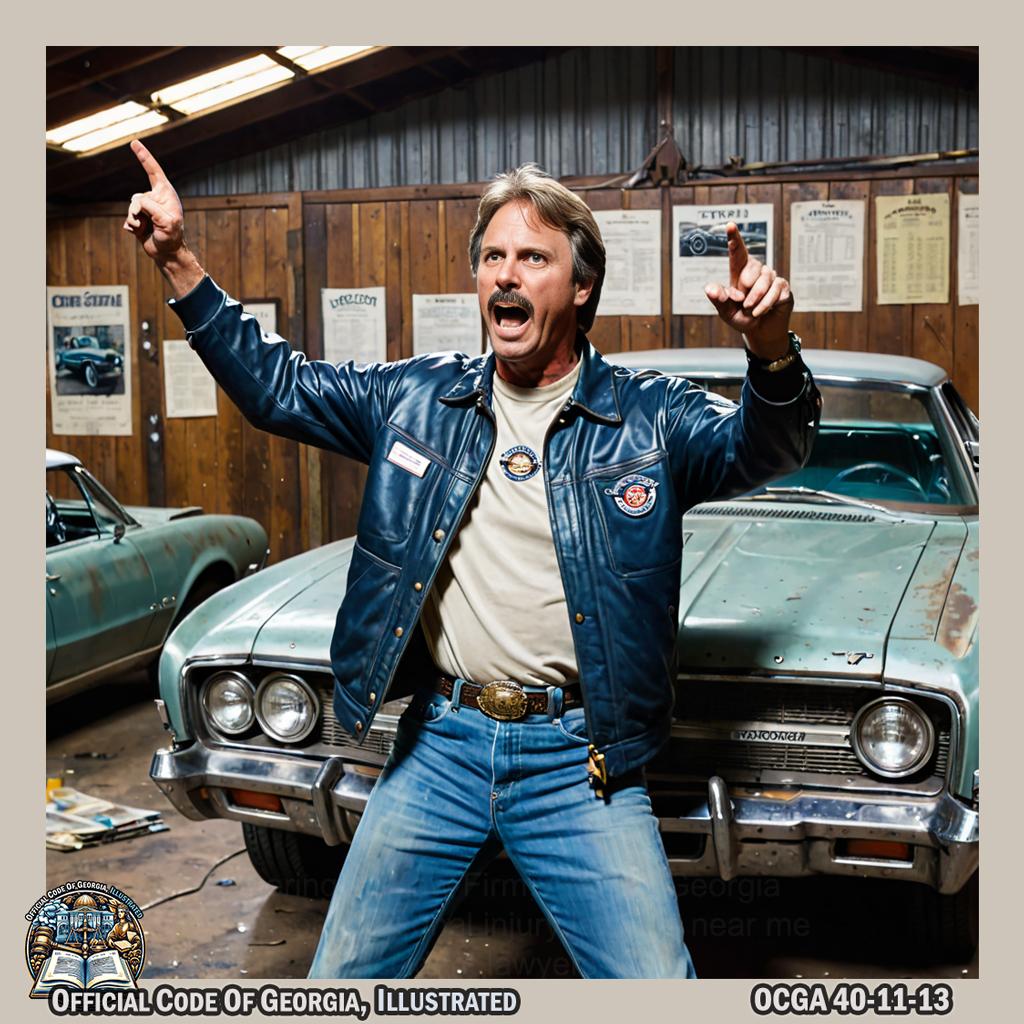
Jeff Foxworthy stands in a dimly lit room, surrounded by vintage motor vehicle parts and antique registration records. He dramatically points to himself as the "secured interest holder" while gesturing towards an imaginary motor vehicle. Suddenly, he shifts into a quirky dance routine, embodying the various individuals listed on the registration records with exaggerated movements and comical expressions, all set against a backdrop reminiscent of Steve McQueen's artistic style. -@foxoutdoors -
“Paid private parking lot” means private property where the owner or operator of a motor vehicle pays a valuable consideration for the right to park in such location.

A person dressed as Jessie James riding a vintage motorcycle, with dramatic lighting and composition reminiscent of Sally Mann's style, pays a parking attendant for the right to park in a private lot while surrounded by lush Savannah scenery. -@popeofwelding -
“Repair facility” means any person maintaining physical custody of a motor vehicle for repairs that have been requested or authorized by an owner or by an insurance company acting on behalf of an owner.

The Allman Brothers Band gently lifting a vintage car hood, surrounded by vibrant colors and geometric shapes in the style of Richard Hamilton, capturing the essence of a repair facility in Vine City, Atlanta. -@allmanbrothers -
“Salvage dealer” means any person taking possession of a motor vehicle from or upon request from an insurance company which is damaged to the extent that its restoration to an operable condition would require the replacement of two or more major component parts or for which the insurance company has paid a total loss claim and has been unable to obtain a certificate of title.

Cecil Alexander dramatically gestures towards a damaged motor vehicle, surrounded by insurance agents and onlookers, capturing the essence of Rembrandt's style in a richly detailed scene set in the bustling 1902 Stock Exchange and Public Opera House. -
“Secured interest holder” means a secured party within the meaning of Code Section 11-9-102 or a person with a perfected encumbrance pertaining to an interest in a motor vehicle.
- “Towing and storage firm” means any person regulated by the Department of Public Safety and in compliance with requirements set forth in Code Section 44-1-13 who removes a motor vehicle from private or public property with or without the consent of the motor vehicle owner or authorized user and provides storage for such motor vehicle after removal.
- “Trailer” means a vehicle with or without motive power designed to be drawn by a motor vehicle; provided, however, that such term shall not include a mobile home as such term is set forth in Code Section 8-2-160 unless such vehicle was left unattended on public property and its removal was requested by a peace officer.
40-11-14.Unattended vehicle checks; completion and attachment of check card; determination if vehicle stolen.¶
-
Any peace officer, or any entity authorized by such peace officer or the Department of Public Safety, who discovers a motor vehicle which has been left unattended on a highway or other public property shall immediately perform an unattended vehicle check on such motor vehicle, unless an unattended vehicle check card is displayed on such motor vehicle, indicating that an unattended vehicle check has been previously performed. For purposes of this Code section, an unattended vehicle check shall consist of such actions as are reasonably necessary to determine that the unattended vehicle does not contain an injured or incapacitated person and to determine that the unattended vehicle does not pose a threat to public health or safety or traffic congestion.

Trenton Brown, dressed in a police officer's uniform, cautiously approaches an unattended motor vehicle on the streets of Chosewood Park. With deliberate and methodical movements, he carefully inspects the exterior and interior of the vehicle to ensure no injured or incapacitated person is inside, while also assessing for any potential threat to public health or safety. His actions are captured in the hyperrealistic style of Ralph Goings' art piece, showcasing every detail with precision and depth. -@Trent -
A peace officer, or any entity authorized by such peace officer or the Department of Public Safety, who completes an unattended motor vehicle check shall attach the completed check card to the vehicle. Unattended vehicle check cards shall be in such form and shall be attached to vehicles in such manner as may be specified by rule or regulation of the Department of Public Safety. Unattended vehicle check cards shall be serially numbered; shall be of a distinctive color and shape, so as to be readily visible to passing motorists; and shall contain spaces for the investigating individual to set forth the location of the vehicle, the date and time of the completion of the unattended vehicle check, and the name of his or her law enforcement or other authorized agency. Detachable stubs shall be included upon such unattended vehicle check cards and shall bear the same serial number and provide for the same information as the portion of the unattended vehicle check card to be left on the vehicle, shall include a space to identify the investigating individual, and shall include a space for the officer to set forth the license plate number and other pertinent identifying information relating to the unattended vehicle. Completed detachable stubs shall be filed with the investigating individual’s law enforcement or other authorized agency. The Department of Public Safety may provide unattended vehicle check cards free of charge if sufficient funds for such purpose are available to the Department of Public Safety.
-
It shall be unlawful for any person other than a peace officer or any entity authorized by such peace officer or the Department of Public Safety to attach any type of unattended motor vehicle check card to a motor vehicle. Any person convicted of violating this subsection shall be guilty of a misdemeanor.
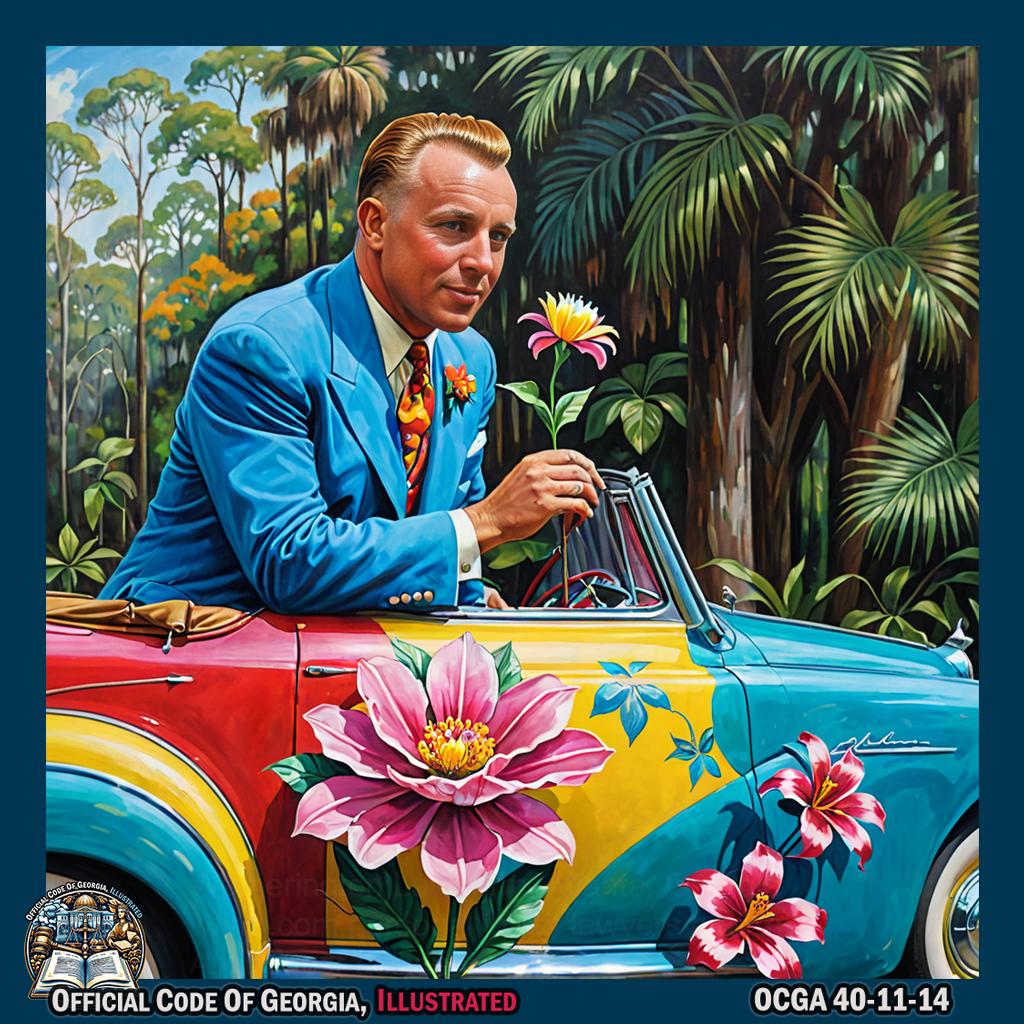
Billy Wright, dressed in a vibrant and colorful costume, gently placing a delicate flower on top of a vintage car at the Tallahassee Museum, while surrounding the scene with whimsical and abstract shapes reminiscent of John Coburn's art. -
Within 24 hours of completing an unattended vehicle check or discovering an unattended motor vehicle with an unattended vehicle check card attached to such vehicle by an authorized individual who is not a peace officer, a peace officer shall query the criminal justice information system to determine if the unattended motor vehicle has been entered into the criminal justice information system as a stolen vehicle. If an unattended vehicle has been reported as stolen, the peace officer shall place a phone call to the law enforcement agency that filed such report, providing the location of the motor vehicle. The law enforcement agency receiving such phone call shall notify the owner of the vehicle of the location of the motor vehicle.
- Failure of a peace officer to comply with any provision of this Code section shall not limit the remedies available to any person pursuant to this article.
40-11-15.Removal of vehicle; liability; duty of towing and storage firm when removal at request of law enforcement.¶
- Any peace officer who finds a motor vehicle which has been left unattended on a highway for more than five days, as evidenced by the date on an unattended vehicle check card, may cause such motor vehicle to be removed to a garage or other place of safety.
- Any peace officer who finds a motor vehicle which has been left unattended on a highway and which poses an immediate threat to public health or safety or traffic congestion may cause such motor vehicle to be removed to a garage or other place of safety. Within 24 hours of causing an unattended motor vehicle to be removed pursuant to this subsection, the peace officer shall query the criminal justice information system to determine if the unattended motor vehicle has been entered into the criminal justice information system as a stolen vehicle. If a removed vehicle has been reported as stolen, the peace officer shall place a phone call to the law enforcement agency that filed such report, providing the name and address of the towing and storage firm that removed the motor vehicle. The law enforcement agency receiving such phone call shall notify the owner of the vehicle of the location of the motor vehicle.
- Any peace officer who causes an unattended motor vehicle to be removed pursuant to this Code section shall be liable only for gross negligence.
- A towing and storage firm that has removed an unattended motor vehicle from public property at the request of a peace officer shall, within three days of the removal, request from the department the identification and addresses of all owners of such vehicle contained in the records of the department; provided, however, that if such vehicle has an out-of-state license plate, such request shall be made to the state where the vehicle is registered or to an entity with access to such state’s vehicle registration information. The department shall furnish the requested owner information no later than five days from the date the request was received. The department may charge a fee of no more than $2.00 for such owner information. For purposes of this subsection, an unattended motor vehicle shall include a motor vehicle required to be moved due to arrest of the vehicle’s operator or any direction of a peace officer.
- Failure of a peace officer to comply with any provision of this Code section shall not limit the remedies available to any person pursuant to this article.
40-11-16.Duty of towing and storage firm when removal at request of property owners; obligations of repair facility or salvage dealer in possession of vehicle.¶
-
- Any towing and storage firm which has removed an unattended motor vehicle from private property at the request of the property owner shall, within three days of the removal, request from the department the identification and addresses of all owners of such vehicle contained in the records of the department; provided, however, that if such vehicle has an out-of-state license plate, such request shall be made to the state where the vehicle is registered or to an entity with access to such state’s vehicle registration information. The department shall furnish the requested owner information no later than five days from the date the request was received. The department may charge a fee of no more than $2.00 for such owner information.
- The towing and storage firm shall submit notification of the removal by hand delivery, electronic transmission, or telephonic facsimile transmission to the law enforcement agency with jurisdiction over the location from where the motor vehicle was removed no later than one day after submission of the request to the department. Within 24 hours of receipt of the copy of the request described in subsection (a) of this Code section, the local law enforcement agency shall query the criminal justice information system to determine if such motor vehicle has been entered into the criminal justice information system as a stolen vehicle. If such vehicle has been reported as stolen, the local law enforcement agency shall place a phone call to the law enforcement agency that filed such report, providing the name and address of the towing and storage firm who submitted a copy of the request described in subsection (a) of this Code section. The law enforcement agency receiving such phone call shall notify the owner of the vehicle of the location of the vehicle and contact information for the towing and storage firm and shall inform the towing and storage firm that the vehicle has been reported as stolen.
- Failure of a peace officer to comply with any provision of this subsection shall not limit the remedies available to any person pursuant to this article.
-
- Any repair facility or salvage dealer which has been in possession of a motor vehicle for at least 15 days without communication from an owner or insurance company and which desires to file a petition pursuant to Code Section 40-11-19.1 shall request from the department the identification and addresses of all owners of such vehicle contained in the records of the department; provided, however, that if such vehicle has an out-of-state license plate, such request shall be made to the state where the vehicle is registered or to an entity with access to such state’s vehicle registration information. For purposes of this paragraph, the term “communication” includes any form of communication which can be verifiably documented.
- The department shall furnish the requested owner information no later than five days from the date the request was received. The department may charge a fee of no more than $2.00 for such owner information.

Matt McClure gracefully extends his hand, presenting the requested owner information in a grand gesture reminiscent of Richard Avedon's artistry.
40-11-17.Removal from private parking lot; fees; penalty.¶
- It shall be unlawful for any person to remove, tow, or immobilize or cause to be removed, towed, or immobilized a motor vehicle left in a paid private parking lot between midnight and 9 A.M. of the following day. Nothing in this Code section shall prohibit the owner or operator of a paid private parking lot from charging a penalty for vehicles which remain in a paid private parking lot during such period without authorization. Such penalty shall not exceed $25.00 in excess of normal parking fees. No owner or operator of a paid private parking lot shall be liable for any damages to any motor vehicle remaining in a paid private parking lot during such period without authorization. Nothing in this Code section shall prohibit a resident or a business owner who is not an owner or operator of a paid private parking lot from towing, removing, immobilizing, or causing to be towed, removed, or immobilized a motor vehicle left without authorization on private property.
- Any person violating the provisions of subsection (a) of this Code section shall be guilty of a misdemeanor.
40-11-18.Retrieval of personal property.¶
- A towing and storage firm, repair facility, or salvage dealer shall allow an owner of a vehicle to retrieve any personal property within a stored vehicle for up to 30 days from the date which notice was sent pursuant to Code Section 40-11-19.
- Any personal property left in a vehicle after 30 days from the date on which notice was sent pursuant to Code Section 40-11-19 shall be considered abandoned.
- For purposes of this Code section, the term “personal property” shall not include any items attached or affixed to the motor vehicle.
40-11-19.Notification letter to owners; advertisement; lien upon vehicle; recoverable fees; form disclaiming ownership; demand letter.¶
-
- Within 15 calendar days of removal or initial storage of a motor vehicle, a towing and storage firm shall send all owners the notification letter form developed by the Council of Magistrate Court Judges for such purpose. Such notification shall be by certified mail or by hand delivery with acknowledgment of such receipt by signature of the owner and a copy of such owner’s driver’s license. Such notification letter shall include, at a minimum:

Sam Madison, dressed in vintage cowboy attire, carefully places a certified mail envelope into an antique mailbox outside of Doc Holliday's Grave site in Griffin, Georgia. He then gestures to the nearby group of onlookers as if proudly displaying his accomplishment. -@sammaddie29
1. The location of the vehicle; 2. The fees connected with the removal of the vehicle, which shall be the maximum allowable charge for the removal of the motor vehicle as set forth by rule and regulation of the Department of Public Safety for maximum state-wide rate tariffs or the rate specified pursuant to an agreement with a local governing authority, except when otherwise exempted or provided for by federal law, rule, or regulation; 3. The daily fees for storage of the vehicle, which shall be the maximum allowable daily rate for the storage of the motor vehicle as set forth by rule and regulation of the Department of Public Safety for maximum state-wide rate tariffs or the rate specified pursuant to an agreement with a local governing authority; 4. A statement informing the recipient that daily fees will accrue until full payment has been made; 5. A statement informing the recipient that the fees which are recoverable by a towing and storage firm include costs for obtaining the owner’s information and notifying the owner, court filing costs, attorney’s fees, and interest; 6. A statement informing the recipient that the towing and storage firm has the right to petition a court to foreclose a lien for all amounts owed after ten calendar days from the date such notice is sent; 7. A statement informing the recipient that a court may order the sale of the vehicle to satisfy the debt; and 8. A form to disclaim ownership interest in the motor vehicle by oath or affirmation as set forth in Code Section 40-11-19.5. - If the identity of the owner cannot be ascertained by the department or the department fails to timely furnish the owner information requested pursuant to Code Section 40-11-15 or 40-11-16, the towing and storage firm shall, within 60 days of such removal, place an advertisement in a newspaper of general circulation or the legal organ in the county where such vehicle was obtained. Any advertisement required by this paragraph shall run in the newspaper once a week for two consecutive weeks. The advertisement shall be in the form provided by the Council of Magistrate Court Judges for such purpose. Such advertisement form shall include a space for describing the motor vehicle’s year, make, model, and manufacturer’s vehicle identification number, the present location of such vehicle, the fact that such vehicle is subject to a lien which can be foreclosed upon, and the fact that such vehicle may be ordered sold to satisfy such lien.
- If the identity of an owner which was previously not ascertained becomes known while an advertisement is run pursuant to paragraph (2) of this subsection, the towing and storage firm shall send a notification letter pursuant to the same requirements set forth in paragraph (1) of this subsection within ten days of obtaining such information.
- Within 15 calendar days of removal or initial storage of a motor vehicle, a towing and storage firm shall send all owners the notification letter form developed by the Council of Magistrate Court Judges for such purpose. Such notification shall be by certified mail or by hand delivery with acknowledgment of such receipt by signature of the owner and a copy of such owner’s driver’s license. Such notification letter shall include, at a minimum:
-
-
When a motor vehicle has been left with a repair facility for at least 15 days, and no later than 180 days, without payment of amounts owed, the repair facility desiring to file a petition pursuant to Code Section 40-11-19.1 shall send all owners by certified mail the notification letter form developed by the Council of Magistrate Court Judges for such purpose. Such notification letter shall include, at a minimum: 1. The location of the vehicle; 2. The fees owed for the repair of the vehicle;
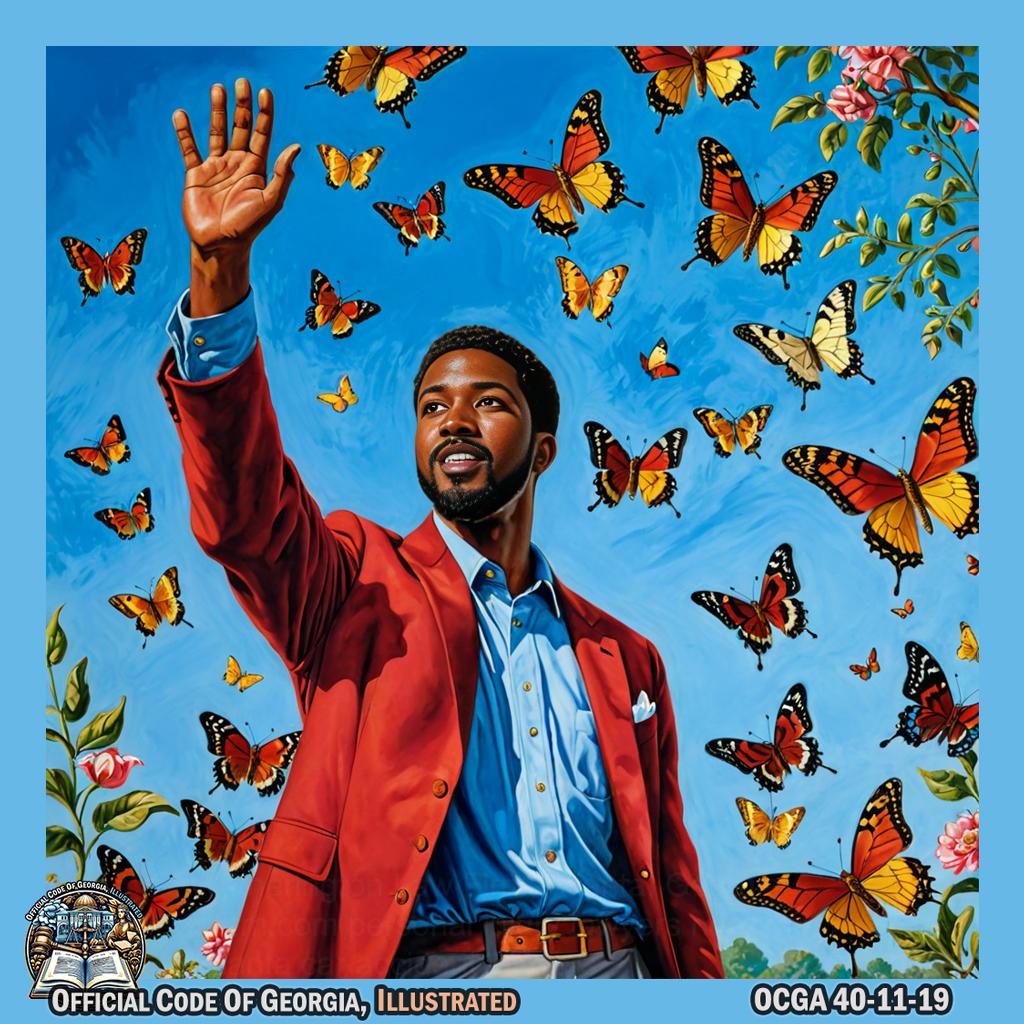
Dexter Fowler gracefully raises his hand towards the sky, as if releasing a flock of butterflies, each representing the fees owed for the repair of the vehicle. The vibrant colors and intricate details capture the essence of Maria Sibylla Merian's art style, set against the rich background of Grovetown, Georgia. -@DexterFowler - The daily fees for storage of the vehicle after completion of the repairs, which shall be the maximum allowable daily rate for the storage of the motor vehicle as set forth by rule and regulation of the Department of Public Safety for maximum state-wide rate tariffs;
-
A statement informing the recipient that daily fees will accrue until full payment has been made;

Gid Tanner and the Skillet Lickers, as depicted in a James Rizzi art piece, become a clock with hands ticking around before suddenly stopping, symbolizing the accumulation of daily fees until full payment is made. -
A statement informing the recipient that the fees which are recoverable by the repair facility include costs for obtaining the owner’s information and notifying the owner, court filing costs, attorney’s fees, and interest;
-
A statement informing the recipient that the repair facility has the right to petition a court to foreclose a lien for all amounts owed in ten calendar days;

Soccer player Morgan Brian, as depicted in an art piece by James Surls, dramatically pounds her fist on an imaginary desk while pointing at an imaginary calendar and then makes a sweeping motion as if declaring something final. -@moeebrian -
A statement informing the recipient that a court may order the sale of the vehicle to satisfy the debt; and
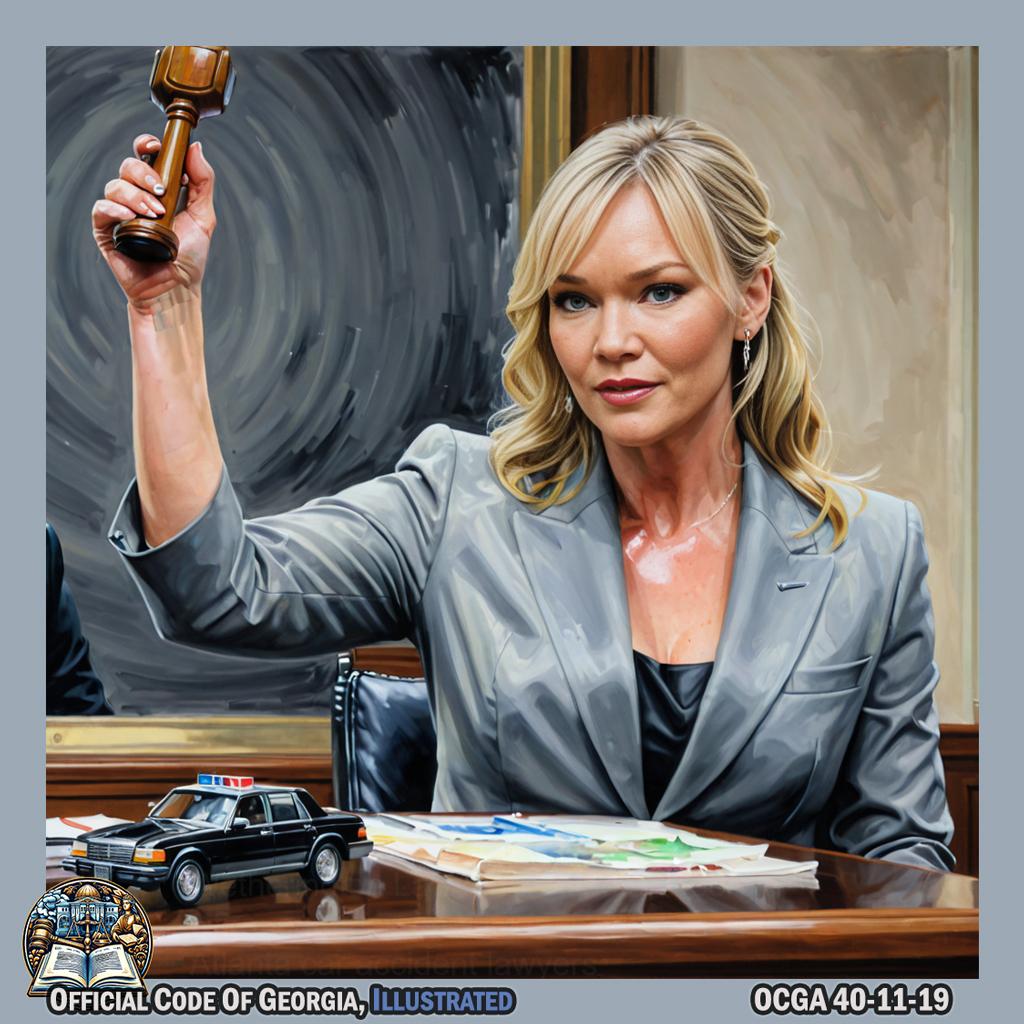
Actress Kelli Giddish, as depicted in a scene resembling an art piece by James Kelly, pretends to be a judge holding an imaginary gavel and pointing to a toy car while making a "sold" sign with her hands. -@KelliGiddish -
A form to disclaim ownership interest in the motor vehicle by oath or affirmation as set forth in Code Section 40-11-19.5.
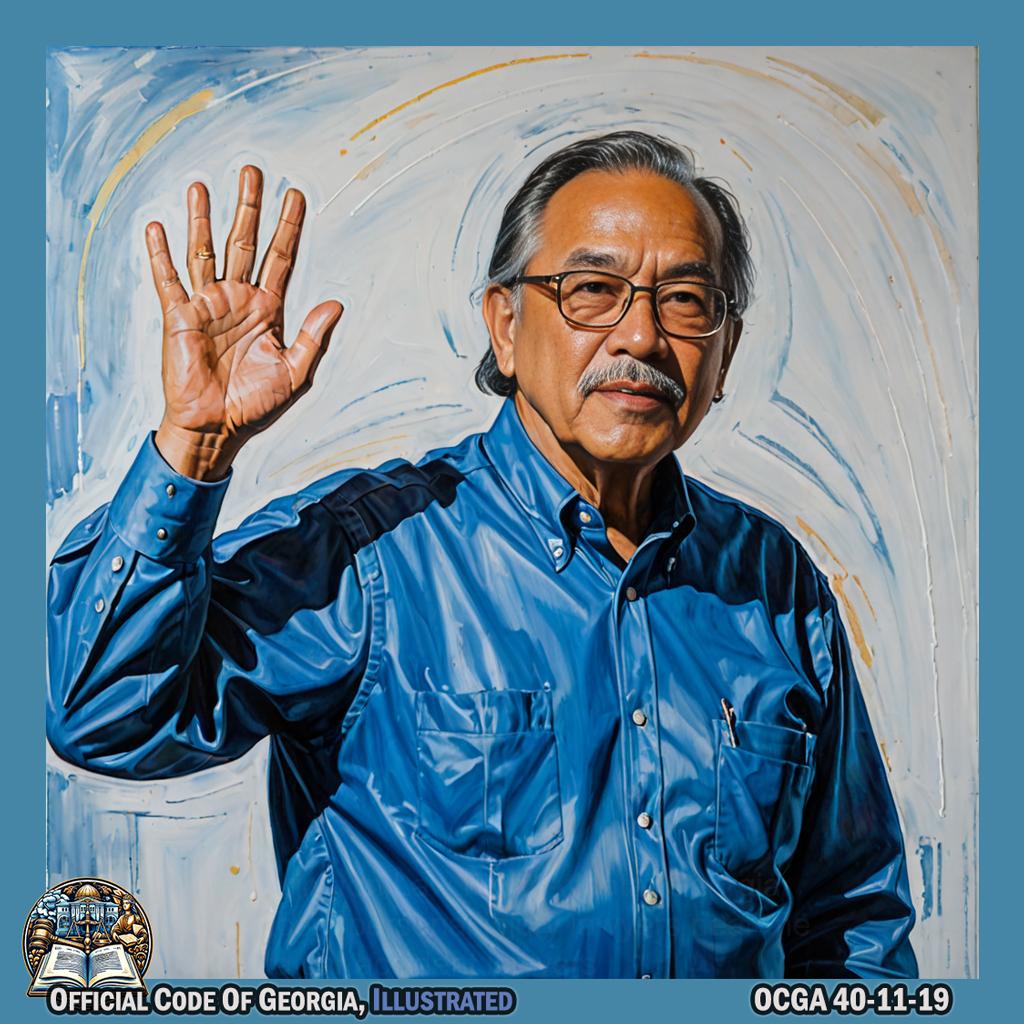
Architect Joe Amisano, inspired by Daisy Youngblood's art, pretends to raise his right hand and makes a dramatic "I solemnly swear" motion while crossing fingers behind his back.
-
If the department fails to timely furnish the information regarding additional owners requested pursuant to Code Section 40-11-16, the repair facility shall, within 60 days of such failure, place an advertisement in a newspaper of general circulation or the legal organ in the county where the repair facility is located. Any advertisement required by this paragraph shall run in the newspaper once a week for two consecutive weeks. The advertisement shall be in the form provided by the Council of Magistrate Court Judges for such purpose. Such advertisement form shall include, at a minimum, a space for describing the motor vehicle, its license and manufacturer’s vehicle identification numbers, the name of the person who left the vehicle with the repair facility, the present location of such vehicle, any information available relating to an owner, the fact that such vehicle is subject to a lien which can be foreclosed upon, and the fact that such vehicle may be ordered sold to satisfy such lien.
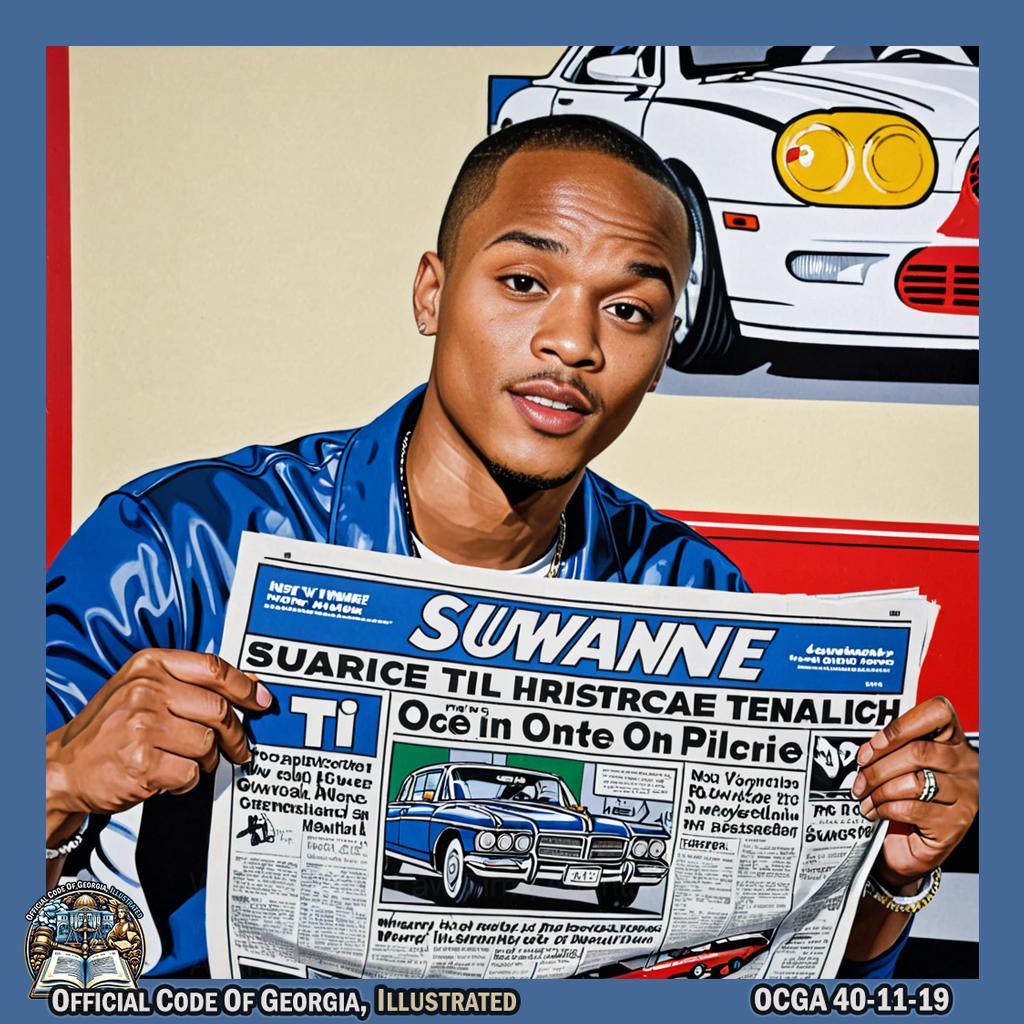
T.I. vividly gestures to a newspaper article, dramatically emphasizing the details of a motor vehicle and its owner, set against a backdrop reminiscent of Roy Lichtenstein's iconic pop art style in Suwanee, Georgia. -@Tip -
If the identity of an owner which was previously not ascertained becomes known while an advertisement is run pursuant to paragraph (2) of this subsection, the repair facility shall send a notification letter pursuant to the same requirements set forth in paragraph (1) of this subsection within ten days of obtaining such information.
-
-
-
When a motor vehicle has been left with a salvage dealer for at least 15 days, and no later than 60 days, after determination by an insurance company to deny the owner’s claim has been communicated to the salvage dealer, the salvage dealer desiring to file a petition to foreclose a lien pursuant to Code Section 40-11-19.1 shall send all owners by certified mail the notification letter form developed by the Council of Magistrate Court Judges for such purpose. Such notification letter shall include, at a minimum:
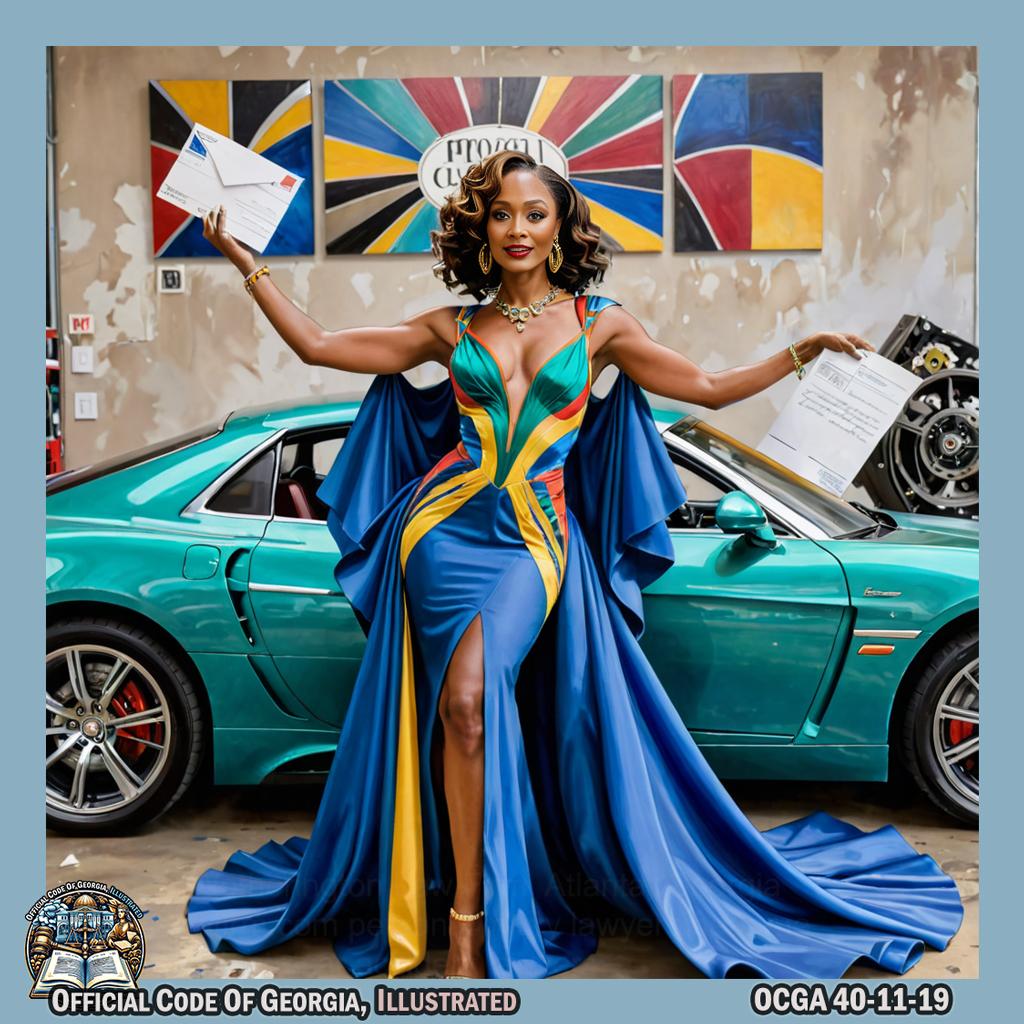
Rozonda Thomas, dressed in a vibrant and flowing gown, gracefully extends her arms as if sending a letter through certified mail, while surrounded by symbolic car parts arranged in an abstract art piece reminiscent of the Art Deco style. -@officialchilli
1. The location of the vehicle;
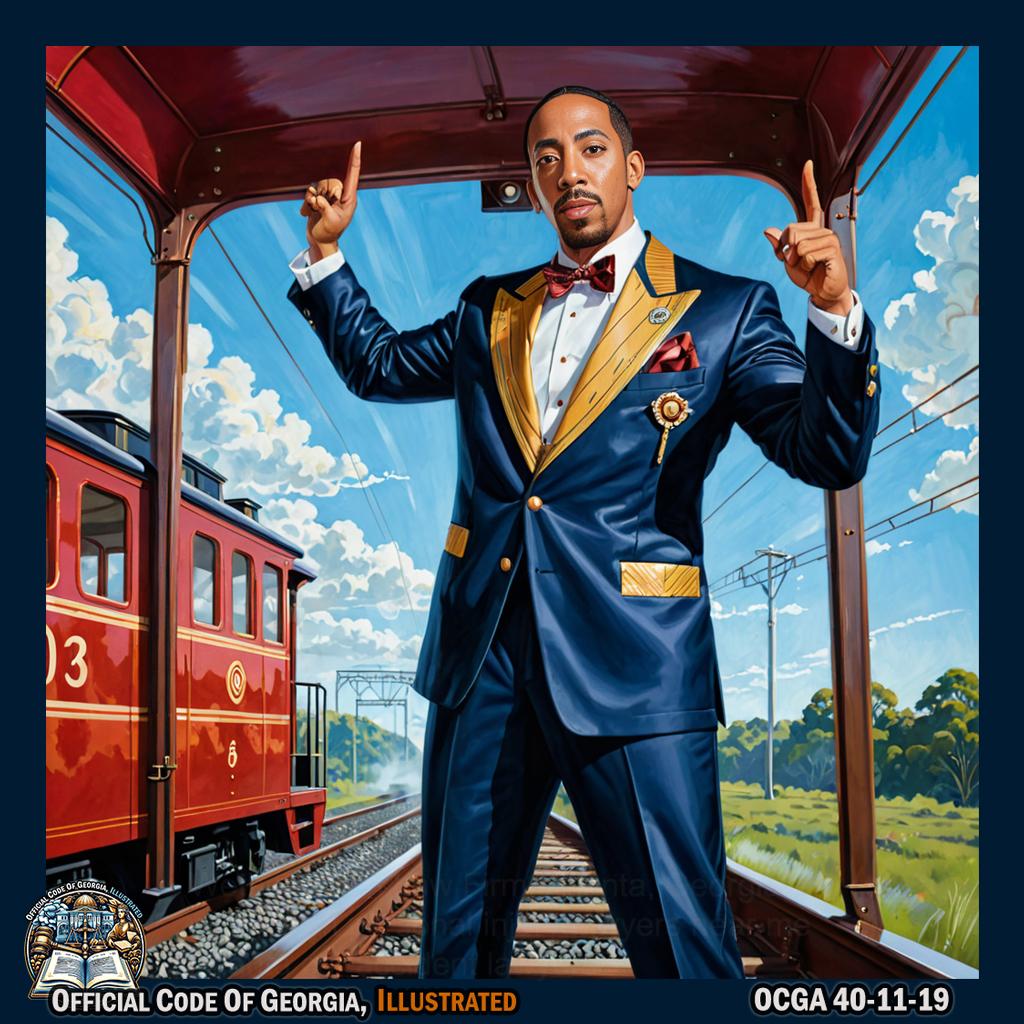
Ludacris stands on the SAM Shortline Railway, pointing dramatically at an empty space, then striking a pose as if he's holding a steering wheel in front of him, while wearing an elaborate costume inspired by art deco design. -@Ludacris - The daily fees for storage of the vehicle, which shall be the maximum allowable daily rate for the storage of the motor vehicle as set forth by rule and regulation of the Department of Public Safety for maximum state-wide rate tariffs;
- A statement informing the recipient that daily fees will accrue until full payment has been made;
- A statement informing the recipient that the fees which are recoverable by the salvage dealer include costs for obtaining the owner’s information and notifying the owner, court filing costs, attorney’s fees, and interest;
- A statement informing the recipient that the salvage dealer has the right to petition a court to foreclose a lien for all amounts owed in ten calendar days;
- A statement informing the recipient that a court may order the sale of the vehicle to satisfy the debt; and
- A form to disclaim ownership interest in the motor vehicle by oath or affirmation as set forth in Code Section 40-11-19.5.
- If the department fails to timely furnish the information regarding additional owners requested pursuant to Code Section 40-11-16, the salvage dealer shall, within 60 days of the last communication described in paragraph (1) of this subsection, place an advertisement in a newspaper of general circulation or the legal organ in the county where the salvage dealer is located. Any advertisement required by this paragraph shall run in the newspaper once a week for two consecutive weeks. The advertisement shall be in the form provided by the Council of Magistrate Court Judges for such purpose. Such advertisement form shall include, at a minimum, a space for describing the motor vehicle, its license and manufacturer’s vehicle identification numbers, the name of the insurance company from which the vehicle was obtained or which requested the vehicle removal, the present location of such vehicle, any information available relating to an owner, the fact that such vehicle is subject to a lien which can be foreclosed upon, and the fact that such vehicle may be ordered sold to satisfy such lien.
- If the identity of an owner which was previously not ascertained becomes known while an advertisement is run pursuant to paragraph (2) of this subsection, the salvage dealer shall send a notification letter pursuant to the same requirements set forth in paragraph (1) of this subsection within ten days of obtaining such information.
-
-
Any towing and storage firm, repair facility, or salvage dealer shall have a lien on a motor vehicle located on its property in the amount of any unpaid and incurred fees upon compliance with the notice requirements of this Code section. Fees that have actually been incurred by any towing and storage firm, repair facility, or salvage dealer and which are documented to the court are recoverable under such lien and shall be limited to the following:
-
- For a towing and storage firm, the rate specified pursuant to an agreement with a local governing authority if the removal was upon the request of a peace officer, or the maximum allowable charge for the removal of the motor vehicle as set forth by rule and regulation of the Department of Public Safety for maximum state-wide rate tariffs if the removal was not upon the request of a peace officer, except when otherwise exempted or provided for by federal law, rule, or regulation; or
- For a repair facility or salvage dealer, the maximum allowable charge for the removal of the motor vehicle as set forth by rule and regulation of the Department of Public Safety for maximum state-wide rate tariffs;
-
- For a towing and storage firm, the daily storage rate specified pursuant to an agreement with a local governing authority if the removal was upon the request of a peace officer, or the maximum allowable daily rate for storage of the motor vehicle as set forth by rule and regulation of the Department of Public Safety for maximum state-wide rate tariffs if the removal was not upon the request of a peace officer, multiplied by the number of days such motor vehicle has been stored to the date any judgment is issued plus 25 days; or
- For a repair facility or salvage dealer, the maximum allowable daily rate for the storage of the motor vehicle as set forth by rule and regulation of the Department of Public Safety for maximum state-wide rate tariffs multiplied by the number of days such motor vehicle has been stored from the date notification required under this Code section was received to the date any judgment is issued plus 25 days;

A person standing on a stage, gesturing dramatically with their arms and hands while surrounded by large colorful signs and symbols representing different aspects of the sentence. In the background, M. Michele Burns is passionately acting out the meaning of each element in an exaggerated manner, all set against a backdrop resembling Peter Blake's eclectic and vibrant art style.
-
For a repair facility, all outstanding charges or fees for repairs;
- The cost of obtaining owner information from the department pursuant to this article;
- The cost of any notification to owners required by this article, including any costs of advertising;
- The cost to file an action pursuant to Code Section 40-11-19.1 and the cost of the certified order;
-
Attorney’s fees, which shall be 15 percent of the total amount of the lien for recoverable fees and shall be awarded for appearance as attorney of record on the matter before the court; and

Pat Dye standing in a dramatic, angular pose with one arm extended upward and the other bent at an acute angle, as if he is representing a legal case in court, all while surrounded by fragmented shapes and bold colors reminiscent of Georges Braque's style. -
Any prejudgment interest from the date which notification pursuant to this Code section was deemed received at a rate of 4 percent per annum.
Any fees listed in this subsection which have been paid to a towing and storage firm, repair facility, or salvage dealer by an owner or any third party shall not be included in a lien.
-
-
The receipt of a properly notarized form disclaiming ownership in a motor vehicle shall be filed with the action provided for in Code Section 40-11-19.1, but shall not be deemed to relieve a towing and storage firm, repair facility, or salvage dealer of any obligation to any other owners of such vehicle under this article. Such form shall be evidence to be considered by the court in any action filed pursuant to Code Section 40-11-19.1.
- If at any time prior to filing a petition to foreclose a lien pursuant to Code Section 40-11-19.1, a repair facility receives a demand from an owner pursuant to subsection (b) of Code Section 40-3-54, such repair facility shall, within 30 days, institute foreclosure proceedings pursuant to such Code section or to Code Section 40-11-19.1. If upon receipt of such demand a repair facility fails to institute foreclosure proceedings pursuant to either Code section, the lien is forfeited. Receipt of such demand shall relieve the repair facility from the notification requirement set forth in paragraph (1) of subsection (b) of this Code section.
40-11-19.1.Petition to foreclose a lien on motor vehicle; answer; motion for judgment; timing; fees.¶
- Not sooner than ten calendar days and not later than six months after compliance with the notice requirements set forth in Code Section 40-11-19, a towing and storage firm, repair facility, or salvage dealer may file an action for a petition to foreclose a lien against the motor vehicle in any magistrate court in the county where the motor vehicle is located. An action filed pursuant to this Code section shall be on a form provided by the Council of Magistrate Court Judges for such purpose and shall be accompanied by a filing fee of no more than $11.00. Any person bringing such action shall include with such form a copy of the owner information obtained pursuant to the request required by Code Section 40-11-15 or 40-11-16 and proof of compliance with the notice requirements set forth in Code Section 40-11-19. The petition to foreclose a lien shall be verified by oath or affirmation by the towing and storage firm, repair facility, or salvage dealer in a manner consistent with Article 5 of Chapter 10 of Title 9.
-
-
The party bringing such action shall send a copy of the oath or affirmation page of the filed petition to any person known to be an owner of the motor vehicle by certified mail or statutory overnight delivery, return receipt requested. The court shall accept electronic documentation as proof that such copy of the filed petition was sent and delivered in accordance with the requirements of this subsection. Included in such mailing shall be a copy of a standardized answer form provided by the Council of Magistrate Court Judges for such purpose. Such form shall require oath or affirmation of the respondent and shall include space to set forth: 1. The name of the owner; 2. The address at which the owner resides; 3. A description of the motor vehicle, including the license plate number and the model, make, and year of the vehicle; 4. A description of the date the owner obtained an interest in the motor vehicle; 5. A brief statement as to why removal of the vehicle was unauthorized, if applicable; 6. Any other brief statement as to why the lien claimed by the towing and storage firm, repair facility, or salvage dealer is invalid;

Tommy Roe, in the style of Philip Pearlstein, strikes a pose embodying the sentence "Any other brief statement as to why the lien claimed by the towing and storage firm repair facility or salvage dealer is invalid," against a backdrop inspired by Buford. -@TommyRoeMusic - A copy of any documentation in the owner’s possession supporting his or her answer; and
- Any additional facts supporting the owner’s answer or as to why the lien should not be foreclosed upon.
- If notice required under Code Section 40-11-19 was satisfied by advertisement, or the signed proof of receipt of a copy of the petition required to be sent under paragraph (1) of this subsection has not been returned after ten days of such mailing or has been returned as unclaimed, the party filing the petition shall, within 60 days, place an advertisement in a newspaper of general circulation or the legal organ where such action has been filed. No such advertisement shall be required if the return receipt required as proof of delivery has been returned with a notation that the notice of the filing of the petition has been refused. Such notice shall run in the newspaper once a week for two consecutive weeks. Such notice shall include instructions for how an owner may obtain the standardized answer form described in this subsection and shall be deemed as notice to any and all persons having an interest in or right affected by such petition and from any sale of the motor vehicle resulting therefrom.
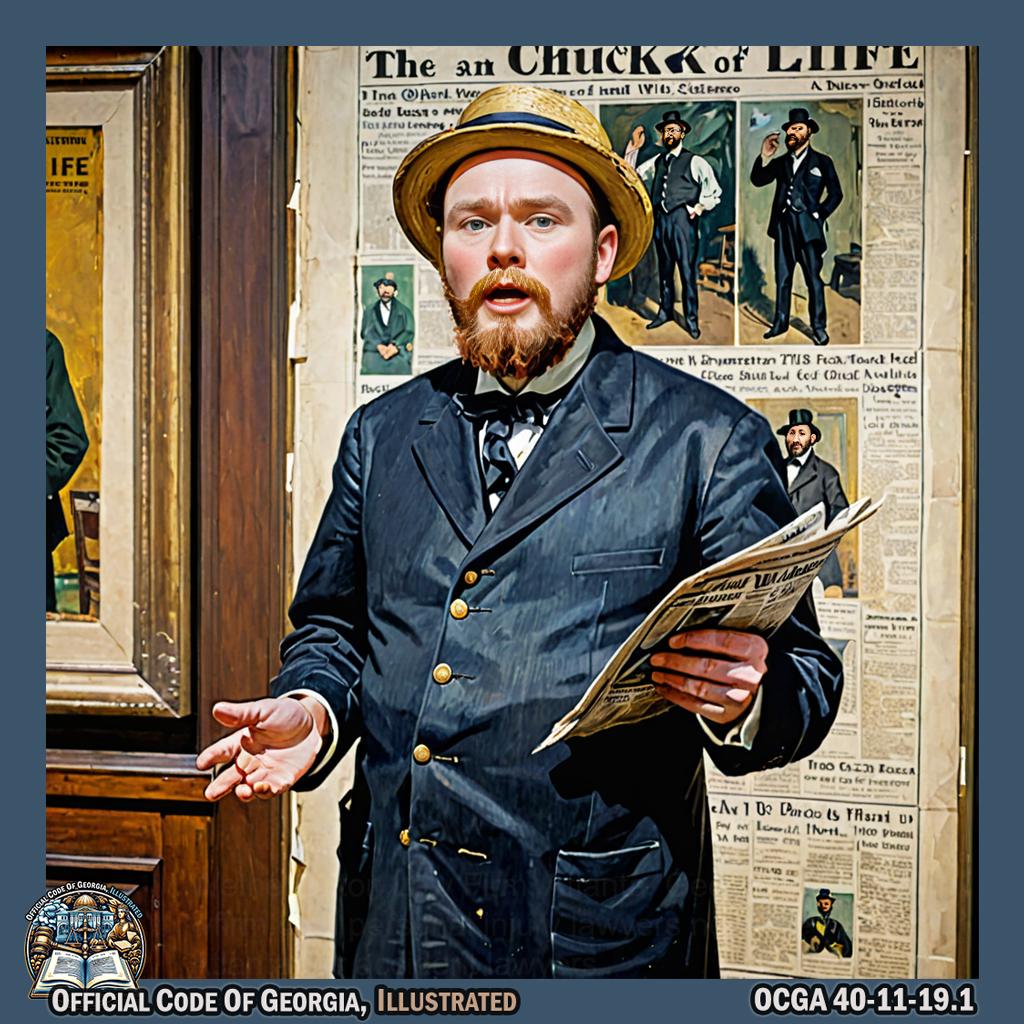
A person dressed as Chuck Willis stands in the Museum of Life and Science, posing dramatically as if placing an advertisement in a newspaper, with exaggerated hand gestures and facial expressions reminiscent of Édouard Manet's style.
- If notice required under Code Section 40-11-19 was satisfied by advertisement, or the signed proof of receipt of a copy of the petition required to be sent under paragraph (1) of this subsection has not been returned after ten days of such mailing or has been returned as unclaimed, the party filing the petition shall, within 60 days, place an advertisement in a newspaper of general circulation or the legal organ where such action has been filed. No such advertisement shall be required if the return receipt required as proof of delivery has been returned with a notation that the notice of the filing of the petition has been refused. Such notice shall run in the newspaper once a week for two consecutive weeks. Such notice shall include instructions for how an owner may obtain the standardized answer form described in this subsection and shall be deemed as notice to any and all persons having an interest in or right affected by such petition and from any sale of the motor vehicle resulting therefrom.
-
If the identity of an owner which was previously not ascertained becomes known while an advertisement is run pursuant to paragraph (2) of this subsection, the party filing a petition to foreclose shall send a copy of the filed petition pursuant to the same requirements set forth in paragraph (1) of this subsection within ten days of obtaining such information.
-
-
An owner may file an answer to the petition no later than ten days after receipt by using the standardized answer form provided. If service is made by advertisement pursuant to paragraph (2) of subsection (b) of this Code section, an owner may file an answer no later than ten days after the expiration of the required two-week advertisement.

Mickey Thomas, with a look of determination, theatrically mimes opening an envelope and pulling out a form. He then strides across a cobblestone street in Dublin, passing by the vibrant greens of St. Stephen's Green park, to an ornate mailbox where he performs an exaggerated gesture of dropping the answer form into the slot. The scene is painted with Liepke's signature lush brushwork and rich colors, capturing Thomas's flowing scarf and the dynamic movement of his action against a backdrop of historic Georgian architecture under a soft Irish sky. -@Mickey_Thomas -
If no answer has been filed at the expiration of the period set forth in subsection (c) of this Code section, the towing and storage firm, repair facility, or salvage dealer may seek to foreclose the lien through a judgment as provided in Code Section 15-10-43 by making such request in writing and submitting to the court proof of service as set forth in subsection (b) of this Code section. Unless providentially hindered, it shall be the duty of the judge to decide all motions for judgment submitted pursuant to this subsection no later than 15 days from when such motion has been made. When a judgment is granted, the vehicle shall be considered abandoned and within five days the court shall issue an order for the disposition of the motor vehicle as provided for in Code Section 40-11-19.2. A certified copy of such order shall be issued by the clerk of court. A fee of no more than $14.00 may be charged for a certified copy of such order, which shall be issued by the clerk of court. If no answer has been filed but the court finds that a petition fails to comply with the requirements of this article, a petition may be refiled for such action once within six months of the issuance of denial of a judgment.

Ty Cobb, dressed in vintage baseball attire, stands before a grand stone wall at Fort Mountain Rock Fort. With a dramatic flair reminiscent of Eugène Delacroix's style, he passionately pleads his case to the court by gesturing and presenting written proof of service while embodying the essence of seeking foreclosure through judgment as provided in Code Section. -
- If an answer is returned to the court, a trial shall be held within ten days after receipt of such answer; provided, however, that such trial may be continued by the court for good cause shown by either party.
- At the trial, the court shall hear evidence of and determine whether the removal of the vehicle was lawful, whether the lien amount is based upon recoverable fees as set forth in subsection (d) of Code Section 40-11-19, and whether notice to all owners was proper, and shall hear any other facts pertinent to the case to reach a decision on foreclosure of the lien. The court may hear evidence of and make a determination on whether storage fees should accrue after the filing date of the petition. Upon conclusion of the trial, the court shall issue a decision on whether to foreclose the lien for the recoverable fees set forth in subsection (d) of Code Section 40-11-19 and, if foreclosure is granted, the court shall order the disposition of the motor vehicle as provided for in Code Section 40-11-19.2. A fee of no more than $14.00 may be charged for a certified copy of such order which shall be issued by the clerk of court.
40-11-19.2.Public sale authorized upon court order; procedure following satisfaction of lien; disposition of excess proceeds.¶
-
- As used in this subsection, the term “public sale” means a sale: 1. Held at a place reasonably available to persons who might desire to attend and submit bids; 2. At which those attending shall be given the opportunity to bid on a competitive basis; and 3. Except as otherwise provided in Title 11 for advertising or dispensing with the advertising of public sales, of which notice is given by advertisement once a week for two weeks in the newspaper in which the sheriff’s advertisements are published in the county where the sale is to be held, and which notice shall state the day and hour, between 9:00 A.M. and 5:00 P.M., and the place of sale and shall briefly identify the motor vehicle to be sold.
- Upon order of the court issued pursuant to Code Section 40-11-19.1, the towing and storage firm, repair facility, or salvage dealer shall be authorized to sell the motor vehicle to the highest and best bidder at public sale.
-
After satisfaction of the lien, the towing and storage firm, repair facility, or salvage dealer selling such motor vehicle shall, not later than 15 days after the date of such sale, provide the Department of Revenue by electronic means a copy of the bill of sale as provided to the purchaser and turn the remaining proceeds of such sale, if any, over to the department to be treated as unclaimed property pursuant to Article 5 of Chapter 12 of Title 44, the “Disposition of Unclaimed Property Act.” The towing and storage firm, repair facility, or salvage dealer selling such vehicle may deduct from such proceeds the cost incurred by the advertisement of the public sale, provided that such amount is no greater than $120.00, and the cost incurred by the holding of the public sale, provided that the cost is no greater than $200.00. Any deduction so made shall be evidenced by receipts or on a form prescribed by the Department of Revenue for such purpose through rule and regulation. Any person convicted of failing to comply with the requirements of this subsection shall be subject to a civil penalty as provided for in Article 5 of Chapter 12 of Title 44.
40-11-19.3.Certified copy of court order; obtaining certificate of title.¶
The purchaser of a motor vehicle at a sale authorized in this article shall receive a certified copy of the court order from the seller of the vehicle authorizing such sale. Any such purchaser may obtain a certificate of title to such motor vehicle by filing the required application, paying the required fees, and filing a certified copy of the order of the court with the Department of Revenue. The Department of Revenue shall then issue a certificate of title, which shall be free and clear of all liens and encumbrances.

40-11-19.4.Development and publication of forms by the Council of Magistrate Court Judges; requirements.¶
Any forms required to be made available by the Council of Magistrate Court Judges under this article shall be developed and published no later than September 1, 2019. Such forms shall be no longer than one page per form, front and back, and every effort shall be made to consolidate any required notice or mailing to a single page.
40-11-19.5.Form for disclaimer of motor vehicle ownership interest.¶
DISCLAIMER OF MOTOR VEHICLE OWNERSHIP INTEREST Georgia, County I, (name of motor vehicle owner) do hereby swear that I disclaim any and all ownership interest in: (motor vehicle year, model, and make) (vehicle identification number (VIN)) (vehicle registration number, if available) I understand that by signing this form I will no longer hold any rights to the above listed vehicle and such vehicle may be sold at auction to satisfy a debt related to a lien filed against the vehicle. I further understand that disclaiming an ownership interest in this vehicle does not relieve me of any other debts related to such vehicle, such as a debt entered into for the purchase of such vehicle. By signing this form, I understand that I waive all future notices to which I am entitled under Article 1A of Chapter 11 of Title 40 of the Official Code of Georgia Annotated, “The Abandoned Motor Vehicle Act.” Owner signature Sworn to and subscribed in County, Georgia, This (date) Before me: (Notary public signature, seal, and commission expiration date). If you wish to disclaim ownership, return this completed and notarized form to (name and address of party owed fees).

Click to view
Article 2 Civil Forfeiture of Vehicles and Components¶
- 40-11-20. Items subject to civil forfeiture.
-
40-11-21. Assignment of new identification numbers prior to disposition of property.

Former U.S. President Jimmy Carter draws a big, colorful "NEW ID NUMBERS" sign at the Dungeness Ruins on Cumberland Island in St. Marys, Georgia and sticks it onto various objects before pretending to give them away. -
40-11-22 through 40-11-24. [Repealed]

Lucas Sims, the baseball player, rips a paper in half at the Juliette Gordon Low Birthplace in Georgia and tosses the pieces into the air like confetti.
40-11-20.Items subject to civil forfeiture.¶
The following items are declared to be contraband and are subject to forfeiture in accordance with the procedures set forth in Chapter 16 of Title 9:
- Any motor vehicle the manufacturer’s vehicle identification number of which has been removed, altered, defaced, falsified, or destroyed; and
- Any component part of a motor vehicle the manufacturer’s identification number of which has been removed, altered, defaced, falsified, or destroyed.
40-11-21.Assignment of new identification numbers prior to disposition of property.¶
Prior to the property’s being sold or returned to the owner or otherwise disposed of, the Department of Revenue shall assign it a new identification number. If the property is to be returned to the owner, the court shall order that such return is conditioned on the owner paying the expenses relating to the civil forfeiture, including the expenses of maintenance of custody, advertising, and court costs.
